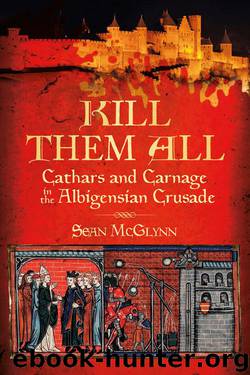Kill Them All: Cathars and Carnage in the Albigensian Crusade by Sean McGlynn

Author:Sean McGlynn [McGlynn, Sean]
Language: eng
Format: epub, azw3
Published: 2016-01-17T16:00:00+00:00
Winter and Spring: The Diplomatic War
The first half of 1213 saw a respite in crusading, a war of words replacing the war of weapons. The diplomatic activity was intense as both sides pleaded their case with Rome. At the beginning of January, King Peter travelled with a large entourage to Toulouse, where he stayed for a month. In itself, this was a strong declaration of support for Count Raymond. At an ecclesiastical council at Lavaur on 16 January, the king put forward his case for Count Raymond, who was willing to make all amends with the Church, emphasising that the count’s son was blameless and should inherit his father’s lands, and that his vassals, the counts of Foix and Comminges and Viscount Gaston de Béarn, have their lands restored (as the pope was to insist in letters written in the following two days). The council of some twenty archbishops and bishops paid little heed to the monarch. They also refused his request for a truce until Easter, understandably fearing that this would result in the supply of crusade reinforcements drying up.
Peter’s son, 6-year-old James, was still in Montfort’s court as a privileged hostage, although that term was not employed. Nonetheless, the king felt not only compelled to act but strong enough to do so: insulted at Pamiers and rebuffed at Lavaur, he now openly sided with the southerners against his new, overmighty vassal in Languedoc. The attempts to disinherit Count Raymond’s son upset many concerned about the precious rights of noble inheritance. King Philip of France was overlord of Toulouse; he was not prepared to let the crusaders dictate who should be the region’s count, even though Montfort would pay homage to him for it. As the pope reminded the crusaders, the count was still not found guilty of heresy or of Peter of Castelnau’s murder. Furthermore, the younger Raymond had powerful connections as nephew to King John of England and also King Peter’s son-in-law.
Toulouse and Montauban offered homage to King Peter to come formally under his protection, thereby making all the chief southern lords his vassals. This encouraged other southern lords to follow. And, most of all, in mid-January, Pope Innocent suspended preaching of the crusade in southern France and instead redirected all new pilgrims to the new expedition planned for the Holy Land. The Albigensian Crusade was now officially on hold. It seemed that all Montfort now had available to him was his small permanent army of colonisation and what mercenaries and local troops his funds could buy. Leaving some troops behind in Toulouse, Peter returned to Aragón and prepared for war.
According to the end of William of Tudela’s chronicle, King Peter ‘said that he would bring at least a thousand knights, all paid by him and, if he could only find the crusaders, would face them in battle … He summoned his men from his entire kingdom and gathered a great and noble company.’ William wrote, ‘And we, if we live long enough, shall see who wins and we will set down what we recall, we will continue to record the events we remember.
Download
Kill Them All: Cathars and Carnage in the Albigensian Crusade by Sean McGlynn.azw3
This site does not store any files on its server. We only index and link to content provided by other sites. Please contact the content providers to delete copyright contents if any and email us, we'll remove relevant links or contents immediately.
| Belgium | France |
| Germany | Great Britain |
| Greenland | Italy |
| Netherlands | Romania |
| Scandinavia |
Room 212 by Kate Stewart(5041)
The Crown by Robert Lacey(4731)
Endurance: Shackleton's Incredible Voyage by Alfred Lansing(4683)
The Iron Duke by The Iron Duke(4293)
The Rape of Nanking by Iris Chang(4139)
Joan of Arc by Mary Gordon(4017)
Killing England by Bill O'Reilly(3953)
Say Nothing by Patrick Radden Keefe(3903)
I'll Give You the Sun by Jandy Nelson(3362)
Shadow of Night by Deborah Harkness(3308)
Hitler's Monsters by Eric Kurlander(3269)
Mary, Queen of Scots, and the Murder of Lord Darnley by Alison Weir(3152)
Blood and Sand by Alex Von Tunzelmann(3140)
Darkest Hour by Anthony McCarten(3072)
Eleanor & Park by Rainbow Rowell(3063)
Margaret Thatcher: The Autobiography by Thatcher Margaret(3029)
Red Famine: Stalin's War on Ukraine by Anne Applebaum(2874)
Book of Life by Deborah Harkness(2869)
The One Memory of Flora Banks by Emily Barr(2803)
